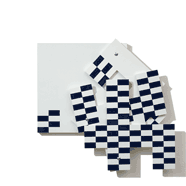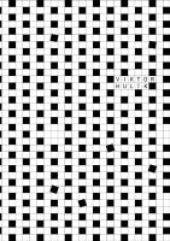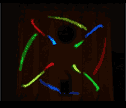About author
EVA TROJANOVÁ RATIONAL OPERATIONS IN VIKTOR HULÍK´S WORK
.
Despite the enormous political pressure and ignorance of society, the generation of artists that emerged in the late 1960s and 1970s rejected the paradigms of Socialist Realism through an open avowal of experimentation. Many artists representing the unofficial art scene strove to express themselves in “avant-garde” or “modernist” language. One of the major themes exploring these tendencies was related to nature in regard to technological progress and its impact on civilisation. Ecology and the threat to man’s immediate environment and our planet became the focal subject matter in that period.
Ecology and questions related to the protection of man and his environment also became dominant themes in the work of many artists. Although ecology was of great importance in the period of mounting political pressure restricting creative thinking, it was the only field in which pent-up energy could be released. Therefore ecology-oriented artworks came to be associated with social and political criticism. It was not incidental that the artists marginalised by society were not indifferent to these issues; just to mention a few, J. Jankovič, J. Meliš, R. Sikora, M. Kern, D. Fischer, M. Mudroch.
The questions of ecology also began to dominate the early work of Viktor Hulík.
The artist focused on the themes of civilisation and technology expressed in geometric shapes. Their first visual forms appeared in the mid-1970s: the figure of man – machine symbolised the relation to a different, man-made nature. Although his work from that period was still figurative, the rational structure of form and space already indicated his future orientation. The early period is characteristic of a strong tension between the expression of structure and geometric articulation of form. This tension reflected, in various periods, the contrast between general and concrete, static and dynamic, natural and civic, real and illusory, planar and spatial, order and chaos. The language of geometry is a characteristic feature of these artworks. Apart from other issues, the dualism of the natural and the civic has remained concealed in Hulík’s artistic creation.
The artist follows the internal philosophical essence of his statement and its artistic expression – the physical character of the art object. Besides classical painting, he is engaged in collage, graphic techniques, especially silkscreen and offset, and in interpreting photographic reproductions. The range of untraditional technologies and their use indicate a profound change in the essence of artistic thinking. In a broader context it was to be fully demonstrated in the 1980s by the emergence of the young generation, who introduced a new dynamic into the artwork, applying relativity, fusion, transformation and diversity.
The most striking philosophical paradigm of Hulík’s work is the relation between order and chaos, reflected in a permanent emergence of new images.
Their articulation went through numerous processes linked with inward logic. In his Transplantations (1981-82), the artist made use of collage to demonstrate the contrast between the order of nature on the photograph, constituting the ground of the picture, and its destruction by crumpled paper. In his Collages (1981), he often used the stapler to emphasise the aspect of destruction, suggesting a violent interference in structure. Whether the picture was created as collage, silkscreen, drawing or painting was of little importance. The basic principle could be expressed in any technology. Along with the contrast between two systems, the contrast between the fictitious and the real, and their mutual link soon appeared.
In his cycle, Penetrations, the artist integrates pictorial and real space. The extension of space beyond the original frame was to have a far-reaching impact on Hulík’s work, opening the way to three, and later to four-dimensional work. This approach brought to fruition his shifters – pictures of diverse images challenging the spectator to co-operate. Meanwhile Hulík tested further possibilities of movement and contrasts of structures on a number of mobile objects – Rotors and Pendulums(1984). The rotors displayed a visible plastic geometric arrangement. The turning of the rotor interfered in the order of pictorial structure, making the image illegible.
The plasticity of collage objects, exploiting the articulation of parallel lines, was expressed in its variants, Shifts, Penetrations and Projections (1985), collages and drawings, whose form anticipated the first movers (1985). They clearly show the composition of geometric screens and the system of work oscillating within order and its destruction.
Movers were based on the system used in Rotors: a mobile set based on the principle of folding meter was attached to a fixed or relief ground. The pictorial surface with the photography of landscape was composed of identical elements. The setting of elements in motion in an arbitrary way created the new variants of a chaotic landscape. Another variant of shifters was the picture of landscape on a firm base, with the mobile part lacking any pictorial depiction. The bits of landscape were revealed by various shifts.
This system appeared to be highly dynamic, revealing countless possibilities of variations. The initial, folded position of the picture changed its image and size in dependence on the manipulation of the movable part. Hulík managed to develop a “non-permanent”, variable pictorial image, which expressed the non-permanence of structures, variability and change within the given system. At the same time he questions the category of permanence. The artist visualises the idea of permanent change, of dynamism as the principle of existence. Rigidity and static are placed in contrast with process and activity. In his artistic exploration of contrasts he realises that no matter how total transformations seem to be, they take place inside the system, changing its organisation not the system itself. Hulík applied this knowledge in another phase of his artistic creation.
In the late 1980s he elaborated the principle of pictorial transformation in the series of BIG Movers. Movable elements arranged in a regular structure, forming the multiple of the basic module, create the destruction of the original image by shifts or side movements.
The pictorial concept continues to oscillate on the low relief surface. Partial changes appeared only in content. While the subject of ecological perception was part of the landscape concept, the issues of structuring the system gradually expanded to the global level. The image of landscape on a fixed or movable part was replaced by colour as a universal category.
In this phase of artistic development Hulík created the spatial concept entitled Homage to Folding Meter. The movable elements, freed from the firm ground of the picture, created spatial geometric configurations.
Parallel with the new arrangement of his spatial concept, the artist was engaged in graphic cycles. Computer graphics enabled him to elaborate on the system used in shifters. The basic module is a horizontally and vertically multiplied element, which creates a regular raster all over the pictorial surface. The shifting of elements disintegrates the system up to the point of the total destruction of surface. The individual phases of disintegration are recorded in the prints from this series. According to the nature of the initial structure, the raster can be differentiated by size, colour or the multiple of smaller structures, and individual phases of the process can be modelled. It is as if certain sequences captured the moment of disintegration, the result of violent interference. The total number of elements used to manipulate the image remains unchanged. It is the same in organised as well as in chaotic structures. Graphics documents the phases of the movement of structure, impossible by shifters. Working with the system of geometric structures, Hulík realises that chaos is a different form of order, a different arrangement of identical elements. He questions the traditional perception of order as a positive and chaos as a negative category.


